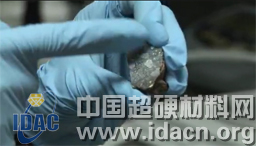Abstract Scientists discovered superhard carbon crystals in a carbon-rich Haverometeorite that fell in Finland in 1971. According to foreign media reports, researchers are polishing a piece of diamond

According to foreign media reports, when researchers polished a piece of meteorite with diamond, they found that there were carbon crystals that were harder than diamonds. This super-hard diamond may not be worn on our hands, but it helps scientists learn how to make harder diamonds in the lab.
It is understood that scientists discovered superhard carbon crystals in a carbon-rich Havero meteorite that fell in Finland in 1971. The researchers polished a piece of meteorite with diamond, and it was surprisingly found that carbon crystals could not be worn away by diamonds, which means that the crystals are harder than diamonds. Scientists used a series of instruments to carefully observe the crystals in the meteorite and discovered two new natural carbon crystal structures. This carbon crystal is harder than the diamond formed inside the earth.
A diamond is a natural crystal with a cubic structure composed of carbon. It is the world's toughest and simplest gemstone, but its chemical composition is basically the same as our common coal and pencil lead. These substances are mainly composed of carbon, but why is the difference so great? It is well known that carbon crystallizes at a higher temperature and pressure to form graphite (black), and in the high temperature, high pressure and reducing environment (usually an oxygen-deficient environment) crystallizes into precious diamonds.
Simply put, diamonds are formed under high pressure and high temperature conditions deep in the earth. The formation of diamonds on the earth is generally at a pressure of 4.5-6.0 Gpa (equivalent to a depth of 150-200 km) and a temperature of 1100-1500 degrees Celsius. Most of the mines currently mined are mainly formed between 3.3 billion years ago and 1.2-1.7 billion years. For example, some diamonds in South Africa are about 4.5 billion years old, indicating that these diamonds have begun to crystallize deep in the earth shortly after the birth of the earth. They are the oldest gemstones in the world. The formation of diamonds requires a long historical process, as evidenced by the fact that diamonds are mainly produced on the ancient stable continents of the earth.
In addition, scientists speculate that the impact of the alien planet on the Earth, producing instantaneous high temperatures, high pressure, can also form diamonds. In fact, before scientists discovered superhard diamonds in this Finnish meteorite, as early as 1988, the Soviet Academy of Sciences reported the discovery of diamonds in meteorites.
Professor Tristan Ferrol of the University of Lyon, France, said: "This discovery is purely accidental, but we are convinced that the study of this meteorite can make new discoveries about diamonds." Ferrol is the first author of the study. The report will be published in the February 15th issue of the Earth and Planetary Science Newsletter.
Chen Changfeng, a diamond researcher at the University of Nevada in the United States, said that the graphite layer of this meteorite has undergone tremendous impact and high temperature heating, enough to bond the different layers together – this is how humans make diamonds. The researchers plan to use a high-precision instrument to observe the structure of the crystal and understand its atomic arrangement to finally unravel its cause.
PPGI And PPGL With Normal Colors
PPGL Roofing Sheet,PPGI Roofing Sheet,Galvanized Sheet Price,PPGI Colour Coated Sheet
SHAOXING YOTO IMPORT&EXPORT CO., LTD , https://www.sxyotoes.com